 Facebook
Facebook
 X
X
 Instagram
Instagram
 TikTok
TikTok
 Youtube
Youtube
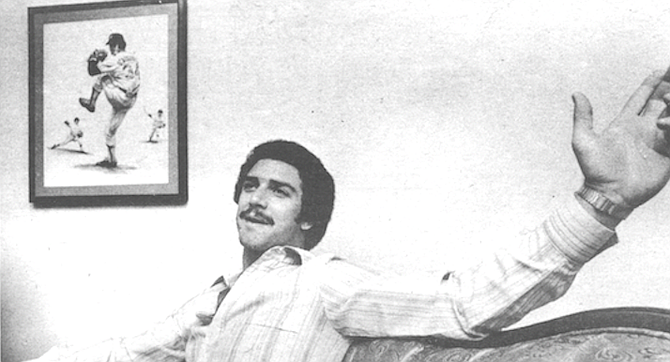
One night during the summer of 1973, John D’Acquisto was pitching for the Phoenix Giants in a game against the Salt Lake City Angels. The game was being played in Salt Lake City, and the air was chilly. With two out and two strikes on the man at the plate, D'Acquisto threw a curve ball for the last pitch of the game and felt something snap in his elbow.
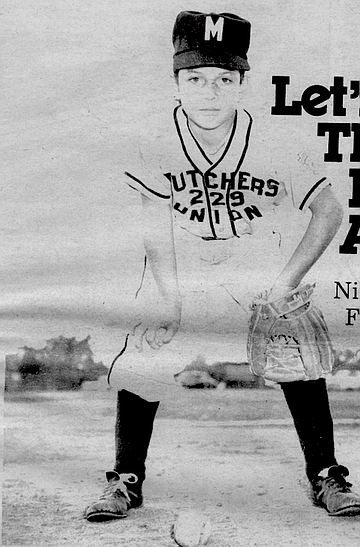
“The pain made me cringe,” he says. “I thought to myself, ‘Whoa, nothing like this ever happened before.’ The next day my elbow had turned black and blue.”
He says this calmly, lifting his arm up to point to the exact spot. We are sitting in an exercise room in the Padres’ clubhouse, beneath the huge complex of San Diego Stadium. Since June of 1977 D’Acquisto has been a member of the Padre organization, the third team he has been with in his major league career.
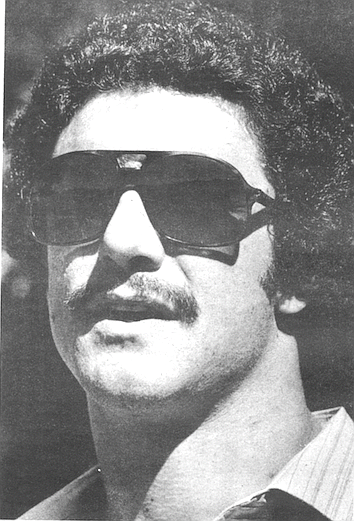
“I had x rays taken that showed a bone chip in my arm,” he continues. “But they gave me anti-inflammatory pills and the pain went away. Five days later I was pitching again.” He shrugs when asked why he came back so quickly. “They told me it wasn’t the type of injury that pitching would aggravate. And I figured if I got a chance to pitch I should take it because there was always someone behind me waiting to try.”
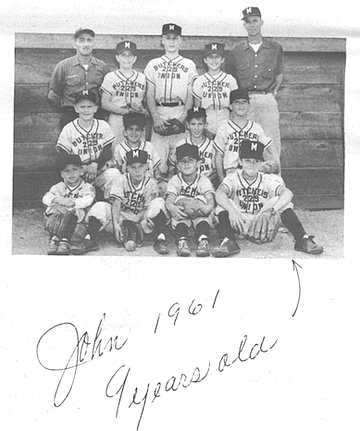
There is an owlish look to D’Acquisto. With his neatly trimmed, frizzy hair, his brown eyes and thin moustache, he looks more like a reggae singer than some youngster’s hero on a baseball card. At twenty-six he has four years’ experience in one of the highest paid professions in the world. But his smile is friendly; he seems unaffected, ready to chat.
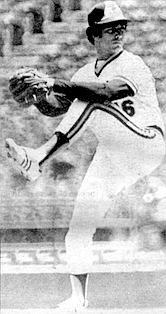
Other Padre players come and go as we talk. Some stop to do sit-ups on an inclined bench nearby. On the other side of the room a player pedals an exercycle, sweating profusely.
“Looking back, I think I came up too fast,” D’Acquisto tells me. “But I had a fantasy— the fantasy of succeeding at something I had always wanted to do.”
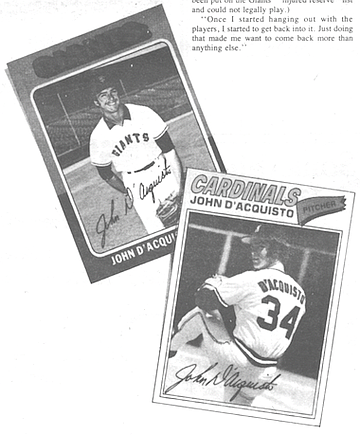
Twelve years ago. one fourteen-year-old against another. D’Acquisto and I faced each other in a Pony League game at Morley Field in San Diego. I mention this to him. adding that he struck me out twice. As we begin to discuss his career, I find welcome consolation in the fact that a lot of other players who have batted against him have done exactly the same thing.
As a senior at St. Augustine High. D’Acquisto already had what scouts described as a “major-league fastball.” Opposing teams scored an average of less than one run when he pitched. With a record of 11-1, he was named Eastern League Player of the Year in 1970: Topps, the company that packages baseball cards with a stick of bubblegum, designated him a high school All American. That spring he was offered an athletic scholarship to USC. He was also drafted by the San Francisco Giants.
“I passed up the scholarship at USC simply because I wanted to get to the major leagues as fast as I could,” he says. “I felt I had a chance to do it with the Giants.”
He was right. By 1973 he was pitching for Phoenix, a professional team just one step below major league baseball. The following spring he was on the Giants' roster. In a classic trial-by-fire, he was called on to pitch in relief against the Los Angeles Dodgers early in the season. The Dodgers were one of the better teams in the league, and that day were proving it by teeing off on the Giants' pitching staff. D’Acquisto faced nine batters; he struck out eight of them. “It was the biggest rush I have ever experienced in my whole life,” he says.
The rest of the year was all he could have hoped for. He became a starting pitcher, struck out 167 men in 215 innings, and won more games than any other rookie in Giants history. The San Francisco press took to calling him “Johnny D.” Vin Scully, the Dodgers' venerable announcer, compared him to a young Sandy Koufax. “I was immature then.” says D'Acquisto. “The publicity got to me. Everyone saying this, saying that. I sucked it up.”
In the spring of 1975 D’Acquisto's arm had not bothered him for a year and a half, since the game-ending curve in Salt Lake City. Suddenly, there was pain in his elbow again.
“I'd be out on the mound during a game and I’d throw a pitch that would make me wince. Someone would come over to ask if everything was all right, and I’d just stand there and say. ‘Sure.’
“I finally told the management about it. and they thought I was joking. The trainer called it tendonitis. They thought it was all up in my head.”
Eventually D’Acquisto conferred with Dr. Robert Kerlan, an orthopedic surgeon who specializes in athletic injuries. After taking X rays, Kerlan suggested removal of three bone chips in D’Acquisto’s right elbow that were damaging the nerve. At least one of the chips had been there since the night he threw the curve in Salt Lake City.
But D’Acquisto is unable to identify anything that might specifically have caused the injury. He says of the pitch, “I didn’t slip; I didn’t do anything. I was just trying to get the ball over the plate. I guess I must have done something wrong. But it couldn't have been too wrong, because the pitch was a strike.” Even among baseball players, pitching is a special talent, a coordination between eye and hand as extraordinary as that of any artist. It is also an extremely unnatural exercise for a human being to undertake. The relatively light weight of the ball and the force of throwing it as hard as possible combine to put tremendous strain on all joints of the arm.
By the time he met with Kerlan. D’Acquisto had pitched more than 900 innings, the equivalent of 100 complete games, since graduating from high school. In his rookie year with the Giants he had also occasionally pitched with less than adequate rest.
Normally a pitcher needs at least four days between starting assignments to insure that he doesn’t overwork his arm. But in 1975 the Giants’ pitching staff was suffering from numerous injuries. “There were times when Charlie Fox (the Giants’ manager) asked me to pitch with only two days’ rest. He’d tell me, ‘You’re young, John, your arm can take it better.’ So I did it. There were a lot of guys vying for the job. and I wanted to show them what I could do.”
On June 9, 1975, D’Acquisto underwent surgery to remove the bone chips and reset the nerve in his right arm. Kerlan told him after the operation that there was a fifty-fifty chance of him ever pitching again. “I didn't like those percentages,” he says. “I definitely got depressed. My fantasy was falling apart.”
The man on the exercycle has been eyeing us for some time now. He seems intrigued by our conversation, but pedals on. D'Acquisto stands up; it's time he started working out.
“I probably should have gone to college,” he says, looking across the room. “I think I would have benefited from the conditioning, particularly at USC. I would have come out with a degree and probably could have gone into professional ball from there. But I’ve been in the major leagues for four years now. Only twenty percent of the players can say that at my age. I have no regrets.”
As I take the elevator back up to ground level, two things stand out in my mind. One is D’Acquisto’s lack of emotion when talking about his career. This trait goes beyond the dispassion one might expect from someone who has been interviewed countless times: he seems to have a very unexcitable character.
The second thing of note is his confidence. It is as if he is trying to bury beneath a positive attitude the problems that have plagued him throughout his career. In doing this he seems to gloss over them.
A few nights later I call D'Acquisto on the telephone. His mother answers; the number he has given me is his parents' house. Speaking with a light Italian accent, she tells me he isn't in.
I ask if she knows when he’ll be back, and she says, “Oh, you know these boys. They say they’re stepping out for five minutes and it turns into two hours." But D'Acquisto calls me back less than half an hour later, and we talk about the difficulty of returning to baseball after an arm operation.
“Well, with only a fifty-fifty chance of coming back at all, I figured I better start looking around for something else to do.” he tells me. “I took a job with the Bank of America, as a special liaison officer for international airlines. I enrolled ip some college courses through the UC Berkeley extension. But I stopped going to games. I got away from baseball, really.”
Two months later, however, he began squeezing a rubber ball as a means of strengthening his right arm. It was the first exercise he had been able to manage since the operation.
“One day the Giants’ owner, and it was Horace Stoneham at the time, called me in. He told me I should put on a uniform and sit in the dugout during games. He said he would arrange it with the league.” (D’Acquisto had been put on the Giants' “injured reserve" list and could not legally play.)
“Once I started hanging out with the players, I started to get back into it. Just doing that made me want to come back more than anything else.”
Simply getting back into shape, however, wasn't enough. Because of the injury. D’Acquisto found himself adjusting his pitching motion to keep pressure off of his elbow . He was not. as he says, "concentrating on a release point.” The result: he was wild.
Not surprisingly, he found it hard to cope with this ineffectiveness. “I lost my confidence and started to make excuses. For one thing. I complained about the way the team was being run. The writers would scribble down everything I said and the next day it would be in the papers. Then the management would call me in and say. ‘Ha ha, very funny John, now you’re going to retract your statement.’ "
One thing led to another, and after the 1976 season D'Acquisto was told he had been traded to the St. Louis Cardinals. He pitched for St. Louis during the spring of 1977, but, still battling control problems, never regained his form. The Cardinals gave up on him in a short time—an unreasonably short time, according to D'Acquisto — and in June, 1977. traded him to San Diego.
“I was apprehensive about returning to my home town." he admits. ”I was worried if I didn't do well, it might put pressure on my family. You know, people coming to my parents and saying, ‘What’s wrong with your son?' "
One senses a certain unwillingness on D'Acquisto's part to talk candidly. He has spoken of being built up, “used” by the media when he was pitching well, and ignored when he was not. He has also implied that since his experience in “popping off“ to journalists in San Francisco, he is wary of saying too much. In spite of being on his guard, though, he seems willing to talk about baseball's effect on his personal life. It is a topic he has apparently thought about more than once.
Married in 1972. D'Acquisto was divorced recently. It was not the injury to his arm, he explains, that brought about the most pressure on his marriage. “After the operation, my wife asked me to stay home more often. She didn't like me traveling all the time. I tried to do it. but even without pitching there were a lot of things I had to go to: banquets, publicity events, parties. And I guess I really wanted to go to them. I'm not much of a homebody.” He admits that his inability to return soon after the operation got him depressed, and that he was unable to shrug this feeling off when he was at home. Still, it was his commitment to coming back and to baseball in general that was most important to him.
"There were times when I was coming up that I realized I would have to sacrifice some things in order to make it as a player. I knew I was going to hurt some people, step on some toes. But it had to be done. And I can say now. it definitely was worth it.”
On a rainy, very windy night I drive to Carlsbad to catch the Padre Caravan at the El Camino Real Shopping Center. Tonight the Padre Caravan features an autograph-signing session with D'Acquisto and another Padre pitcher. Bob Shirley.
A secretary in the Padre office, when asked which store the players would be in front of, advised. “Just look for a crowd of kids.” But as I enter the mall I am led to the scene by a loud-speaker blaring. “Come join the 7-Up Junior Padre Club and get a chance to win a free prize. Meet John D’Acquisto and Bob Shirley of the Padres, and the newest member of our broadcast team . . . .”
A youngish-looking man in a brown suit and glasses is standing in front of a microphone, repeating this information over and over with slight variations. At a table nearby, D'Acquisto and Shirley sit, busily signing action photos of themselves. Sure enough, most of the people lining up to receive these giveaways are kids.
As the crowd thins I walk over and say hello. D'Acquisto greets me cheerfully. In a sport shirt and jeans, he seems to be relaxed and enjoying himself.
"Going to come in first this year?” asks an elderly man. stepping up to the table.
While D'Acquisto signs autographs, I glance at his arm. There is nothing unusual looking about it; it is tanned and well-muscled, the arm of a man who stays in good physical condition. Still, it is because of this arm that he travels throughout the United States with all expenses paid. It is because of this arm that he has been able to own five Porsches in the last six years, and to buy a home in La Jolla. It is because of this arm that he is sitting here, signing his name for kids who will always remember the night they met a big-league baseball player.
But then again, it is more than a physical gift that has brought him here. It is that rare mixture of desire, confidence and self-control, what high school coaches are fond of referring to as “attitude.” In a spare moment, he shares a little of his optimism. “The extra pressure to perform here never really developed. Everyone has been great.
"I'm in excellent shape now; I spent the winter playing ball in Mexico, and in the long run it did me a heck of a lot of good. I struck out 140 men in 140 innings, and walked only 65. I've proved that I have my control back.”
Indeed, D'Acquisto will need all the confidence he can muster, for he is in a precarious position now; spring training and the exhibition season, currently underway, will be crucial. He has not had a good year in the last three, and the owner of the Padres. Ray Kroc, is not a particularly patient man. If D'Acquisto doesn't perform well in the coming weeks the Padres will likely try to trade him—but with two years left on his three-year contract, a trade might be difficult to arrange. In that case the Padres' options would be to send him to Hawaii, their top minor-league club, or give up on him altogether.
Having faced the possibility of his career ending once already, D'Acquisto seems to have adjusted to the prospect of “life after baseball.” When I asked him several days ago what he would do if he couldn’t play, he answered with little hesitation. “Well, I like to cook. I think I'd open an Italian restaurant in La Jolla.”
Still, it is obvious that dropping out of baseball would be difficult. More than anything else, he wants to prove he should again be a starting pitcher. “It’s a little bit of an ego thing.” he says, “but mostly I want to build back a pride that I lost in myself.”
I have been squatting near D’Acquisto's chair as we talk. Now a dark-haired girl about twelve years old approaches the table and asks for my autograph. Embarrassed, I ignore her and turn to D’Acquisto for help. He reaches for one of his publicity photos, and the girl moves over to stand in front of him.
“What's your name?” he asks good-naturedly, picking up a pen.
“Mari Ann.” says the girl, adding shyly, “it's two words — Mari with an 'i' ”


One night during the summer of 1973, John D’Acquisto was pitching for the Phoenix Giants in a game against the Salt Lake City Angels. The game was being played in Salt Lake City, and the air was chilly. With two out and two strikes on the man at the plate, D'Acquisto threw a curve ball for the last pitch of the game and felt something snap in his elbow.

“The pain made me cringe,” he says. “I thought to myself, ‘Whoa, nothing like this ever happened before.’ The next day my elbow had turned black and blue.”
He says this calmly, lifting his arm up to point to the exact spot. We are sitting in an exercise room in the Padres’ clubhouse, beneath the huge complex of San Diego Stadium. Since June of 1977 D’Acquisto has been a member of the Padre organization, the third team he has been with in his major league career.

“I had x rays taken that showed a bone chip in my arm,” he continues. “But they gave me anti-inflammatory pills and the pain went away. Five days later I was pitching again.” He shrugs when asked why he came back so quickly. “They told me it wasn’t the type of injury that pitching would aggravate. And I figured if I got a chance to pitch I should take it because there was always someone behind me waiting to try.”

There is an owlish look to D’Acquisto. With his neatly trimmed, frizzy hair, his brown eyes and thin moustache, he looks more like a reggae singer than some youngster’s hero on a baseball card. At twenty-six he has four years’ experience in one of the highest paid professions in the world. But his smile is friendly; he seems unaffected, ready to chat.

Other Padre players come and go as we talk. Some stop to do sit-ups on an inclined bench nearby. On the other side of the room a player pedals an exercycle, sweating profusely.
“Looking back, I think I came up too fast,” D’Acquisto tells me. “But I had a fantasy— the fantasy of succeeding at something I had always wanted to do.”

Twelve years ago. one fourteen-year-old against another. D’Acquisto and I faced each other in a Pony League game at Morley Field in San Diego. I mention this to him. adding that he struck me out twice. As we begin to discuss his career, I find welcome consolation in the fact that a lot of other players who have batted against him have done exactly the same thing.
As a senior at St. Augustine High. D’Acquisto already had what scouts described as a “major-league fastball.” Opposing teams scored an average of less than one run when he pitched. With a record of 11-1, he was named Eastern League Player of the Year in 1970: Topps, the company that packages baseball cards with a stick of bubblegum, designated him a high school All American. That spring he was offered an athletic scholarship to USC. He was also drafted by the San Francisco Giants.
“I passed up the scholarship at USC simply because I wanted to get to the major leagues as fast as I could,” he says. “I felt I had a chance to do it with the Giants.”
He was right. By 1973 he was pitching for Phoenix, a professional team just one step below major league baseball. The following spring he was on the Giants' roster. In a classic trial-by-fire, he was called on to pitch in relief against the Los Angeles Dodgers early in the season. The Dodgers were one of the better teams in the league, and that day were proving it by teeing off on the Giants' pitching staff. D’Acquisto faced nine batters; he struck out eight of them. “It was the biggest rush I have ever experienced in my whole life,” he says.
The rest of the year was all he could have hoped for. He became a starting pitcher, struck out 167 men in 215 innings, and won more games than any other rookie in Giants history. The San Francisco press took to calling him “Johnny D.” Vin Scully, the Dodgers' venerable announcer, compared him to a young Sandy Koufax. “I was immature then.” says D'Acquisto. “The publicity got to me. Everyone saying this, saying that. I sucked it up.”
In the spring of 1975 D’Acquisto's arm had not bothered him for a year and a half, since the game-ending curve in Salt Lake City. Suddenly, there was pain in his elbow again.
“I'd be out on the mound during a game and I’d throw a pitch that would make me wince. Someone would come over to ask if everything was all right, and I’d just stand there and say. ‘Sure.’
“I finally told the management about it. and they thought I was joking. The trainer called it tendonitis. They thought it was all up in my head.”
Eventually D’Acquisto conferred with Dr. Robert Kerlan, an orthopedic surgeon who specializes in athletic injuries. After taking X rays, Kerlan suggested removal of three bone chips in D’Acquisto’s right elbow that were damaging the nerve. At least one of the chips had been there since the night he threw the curve in Salt Lake City.
But D’Acquisto is unable to identify anything that might specifically have caused the injury. He says of the pitch, “I didn’t slip; I didn’t do anything. I was just trying to get the ball over the plate. I guess I must have done something wrong. But it couldn't have been too wrong, because the pitch was a strike.” Even among baseball players, pitching is a special talent, a coordination between eye and hand as extraordinary as that of any artist. It is also an extremely unnatural exercise for a human being to undertake. The relatively light weight of the ball and the force of throwing it as hard as possible combine to put tremendous strain on all joints of the arm.
By the time he met with Kerlan. D’Acquisto had pitched more than 900 innings, the equivalent of 100 complete games, since graduating from high school. In his rookie year with the Giants he had also occasionally pitched with less than adequate rest.
Normally a pitcher needs at least four days between starting assignments to insure that he doesn’t overwork his arm. But in 1975 the Giants’ pitching staff was suffering from numerous injuries. “There were times when Charlie Fox (the Giants’ manager) asked me to pitch with only two days’ rest. He’d tell me, ‘You’re young, John, your arm can take it better.’ So I did it. There were a lot of guys vying for the job. and I wanted to show them what I could do.”
On June 9, 1975, D’Acquisto underwent surgery to remove the bone chips and reset the nerve in his right arm. Kerlan told him after the operation that there was a fifty-fifty chance of him ever pitching again. “I didn't like those percentages,” he says. “I definitely got depressed. My fantasy was falling apart.”
The man on the exercycle has been eyeing us for some time now. He seems intrigued by our conversation, but pedals on. D'Acquisto stands up; it's time he started working out.
“I probably should have gone to college,” he says, looking across the room. “I think I would have benefited from the conditioning, particularly at USC. I would have come out with a degree and probably could have gone into professional ball from there. But I’ve been in the major leagues for four years now. Only twenty percent of the players can say that at my age. I have no regrets.”
As I take the elevator back up to ground level, two things stand out in my mind. One is D’Acquisto’s lack of emotion when talking about his career. This trait goes beyond the dispassion one might expect from someone who has been interviewed countless times: he seems to have a very unexcitable character.
The second thing of note is his confidence. It is as if he is trying to bury beneath a positive attitude the problems that have plagued him throughout his career. In doing this he seems to gloss over them.
A few nights later I call D'Acquisto on the telephone. His mother answers; the number he has given me is his parents' house. Speaking with a light Italian accent, she tells me he isn't in.
I ask if she knows when he’ll be back, and she says, “Oh, you know these boys. They say they’re stepping out for five minutes and it turns into two hours." But D'Acquisto calls me back less than half an hour later, and we talk about the difficulty of returning to baseball after an arm operation.
“Well, with only a fifty-fifty chance of coming back at all, I figured I better start looking around for something else to do.” he tells me. “I took a job with the Bank of America, as a special liaison officer for international airlines. I enrolled ip some college courses through the UC Berkeley extension. But I stopped going to games. I got away from baseball, really.”
Two months later, however, he began squeezing a rubber ball as a means of strengthening his right arm. It was the first exercise he had been able to manage since the operation.
“One day the Giants’ owner, and it was Horace Stoneham at the time, called me in. He told me I should put on a uniform and sit in the dugout during games. He said he would arrange it with the league.” (D’Acquisto had been put on the Giants' “injured reserve" list and could not legally play.)
“Once I started hanging out with the players, I started to get back into it. Just doing that made me want to come back more than anything else.”
Simply getting back into shape, however, wasn't enough. Because of the injury. D’Acquisto found himself adjusting his pitching motion to keep pressure off of his elbow . He was not. as he says, "concentrating on a release point.” The result: he was wild.
Not surprisingly, he found it hard to cope with this ineffectiveness. “I lost my confidence and started to make excuses. For one thing. I complained about the way the team was being run. The writers would scribble down everything I said and the next day it would be in the papers. Then the management would call me in and say. ‘Ha ha, very funny John, now you’re going to retract your statement.’ "
One thing led to another, and after the 1976 season D'Acquisto was told he had been traded to the St. Louis Cardinals. He pitched for St. Louis during the spring of 1977, but, still battling control problems, never regained his form. The Cardinals gave up on him in a short time—an unreasonably short time, according to D'Acquisto — and in June, 1977. traded him to San Diego.
“I was apprehensive about returning to my home town." he admits. ”I was worried if I didn't do well, it might put pressure on my family. You know, people coming to my parents and saying, ‘What’s wrong with your son?' "
One senses a certain unwillingness on D'Acquisto's part to talk candidly. He has spoken of being built up, “used” by the media when he was pitching well, and ignored when he was not. He has also implied that since his experience in “popping off“ to journalists in San Francisco, he is wary of saying too much. In spite of being on his guard, though, he seems willing to talk about baseball's effect on his personal life. It is a topic he has apparently thought about more than once.
Married in 1972. D'Acquisto was divorced recently. It was not the injury to his arm, he explains, that brought about the most pressure on his marriage. “After the operation, my wife asked me to stay home more often. She didn't like me traveling all the time. I tried to do it. but even without pitching there were a lot of things I had to go to: banquets, publicity events, parties. And I guess I really wanted to go to them. I'm not much of a homebody.” He admits that his inability to return soon after the operation got him depressed, and that he was unable to shrug this feeling off when he was at home. Still, it was his commitment to coming back and to baseball in general that was most important to him.
"There were times when I was coming up that I realized I would have to sacrifice some things in order to make it as a player. I knew I was going to hurt some people, step on some toes. But it had to be done. And I can say now. it definitely was worth it.”
On a rainy, very windy night I drive to Carlsbad to catch the Padre Caravan at the El Camino Real Shopping Center. Tonight the Padre Caravan features an autograph-signing session with D'Acquisto and another Padre pitcher. Bob Shirley.
A secretary in the Padre office, when asked which store the players would be in front of, advised. “Just look for a crowd of kids.” But as I enter the mall I am led to the scene by a loud-speaker blaring. “Come join the 7-Up Junior Padre Club and get a chance to win a free prize. Meet John D’Acquisto and Bob Shirley of the Padres, and the newest member of our broadcast team . . . .”
A youngish-looking man in a brown suit and glasses is standing in front of a microphone, repeating this information over and over with slight variations. At a table nearby, D'Acquisto and Shirley sit, busily signing action photos of themselves. Sure enough, most of the people lining up to receive these giveaways are kids.
As the crowd thins I walk over and say hello. D'Acquisto greets me cheerfully. In a sport shirt and jeans, he seems to be relaxed and enjoying himself.
"Going to come in first this year?” asks an elderly man. stepping up to the table.
While D'Acquisto signs autographs, I glance at his arm. There is nothing unusual looking about it; it is tanned and well-muscled, the arm of a man who stays in good physical condition. Still, it is because of this arm that he travels throughout the United States with all expenses paid. It is because of this arm that he has been able to own five Porsches in the last six years, and to buy a home in La Jolla. It is because of this arm that he is sitting here, signing his name for kids who will always remember the night they met a big-league baseball player.
But then again, it is more than a physical gift that has brought him here. It is that rare mixture of desire, confidence and self-control, what high school coaches are fond of referring to as “attitude.” In a spare moment, he shares a little of his optimism. “The extra pressure to perform here never really developed. Everyone has been great.
"I'm in excellent shape now; I spent the winter playing ball in Mexico, and in the long run it did me a heck of a lot of good. I struck out 140 men in 140 innings, and walked only 65. I've proved that I have my control back.”
Indeed, D'Acquisto will need all the confidence he can muster, for he is in a precarious position now; spring training and the exhibition season, currently underway, will be crucial. He has not had a good year in the last three, and the owner of the Padres. Ray Kroc, is not a particularly patient man. If D'Acquisto doesn't perform well in the coming weeks the Padres will likely try to trade him—but with two years left on his three-year contract, a trade might be difficult to arrange. In that case the Padres' options would be to send him to Hawaii, their top minor-league club, or give up on him altogether.
Having faced the possibility of his career ending once already, D'Acquisto seems to have adjusted to the prospect of “life after baseball.” When I asked him several days ago what he would do if he couldn’t play, he answered with little hesitation. “Well, I like to cook. I think I'd open an Italian restaurant in La Jolla.”
Still, it is obvious that dropping out of baseball would be difficult. More than anything else, he wants to prove he should again be a starting pitcher. “It’s a little bit of an ego thing.” he says, “but mostly I want to build back a pride that I lost in myself.”
I have been squatting near D’Acquisto's chair as we talk. Now a dark-haired girl about twelve years old approaches the table and asks for my autograph. Embarrassed, I ignore her and turn to D’Acquisto for help. He reaches for one of his publicity photos, and the girl moves over to stand in front of him.
“What's your name?” he asks good-naturedly, picking up a pen.
“Mari Ann.” says the girl, adding shyly, “it's two words — Mari with an 'i' ”
Comments